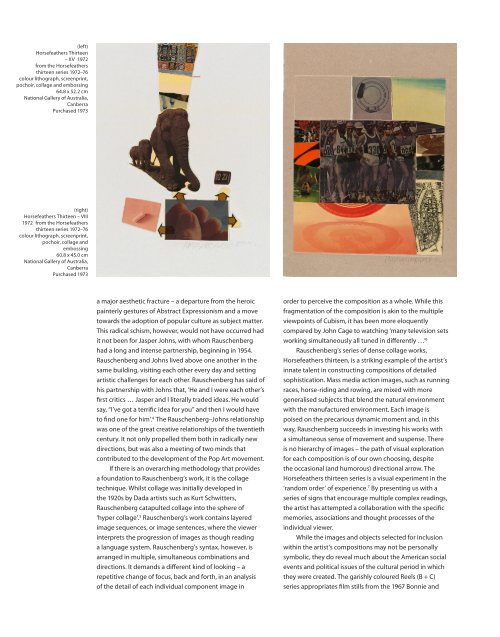Download Room Brochure - National Gallery of Australia
Download Room Brochure - National Gallery of Australia
Download Room Brochure - National Gallery of Australia
Create successful ePaper yourself
Turn your PDF publications into a flip-book with our unique Google optimized e-Paper software.
(left)<br />
Horsefeathers Thirteen<br />
– XV 1972<br />
from the Horsefeathers<br />
thirteen series 1972–76<br />
colour lithograph, screenprint,<br />
pochoir, collage and embossing<br />
64.8 x 52.2 cm<br />
<strong>National</strong> <strong>Gallery</strong> <strong>of</strong> <strong>Australia</strong>,<br />
Canberra<br />
Purchased 1973<br />
(right)<br />
Horsefeathers Thirteen – VIII<br />
1972 from the Horsefeathers<br />
thirteen series 1972–76<br />
colour lithograph, screenprint,<br />
pochoir, collage and<br />
embossing<br />
60.8 x 45.0 cm<br />
<strong>National</strong> <strong>Gallery</strong> <strong>of</strong> <strong>Australia</strong>,<br />
Canberra<br />
Purchased 1973<br />
a major aesthetic fracture – a departure from the heroic<br />
painterly gestures <strong>of</strong> Abstract Expressionism and a move<br />
towards the adoption <strong>of</strong> popular culture as subject matter.<br />
This radical schism, however, would not have occurred had<br />
it not been for Jasper Johns, with whom Rauschenberg<br />
had a long and intense partnership, beginning in 1954.<br />
Rauschenberg and Johns lived above one another in the<br />
same building, visiting each other every day and setting<br />
artistic challenges for each other. Rauschenberg has said <strong>of</strong><br />
his partnership with Johns that, ‘He and I were each other’s<br />
first critics … Jasper and I literally traded ideas. He would<br />
say, “I’ve got a terrific idea for you” and then I would have<br />
to find one for him’. 4 The Rauschenberg–Johns relationship<br />
was one <strong>of</strong> the great creative relationships <strong>of</strong> the twentieth<br />
century. It not only propelled them both in radically new<br />
directions, but was also a meeting <strong>of</strong> two minds that<br />
contributed to the development <strong>of</strong> the Pop Art movement.<br />
If there is an overarching methodology that provides<br />
a foundation to Rauschenberg’s work, it is the collage<br />
technique. Whilst collage was initially developed in<br />
the 1920s by Dada artists such as Kurt Schwitters,<br />
Rauschenberg catapulted collage into the sphere <strong>of</strong><br />
‘hyper collage’. 5 Rauschenberg’s work contains layered<br />
image sequences, or image sentences, where the viewer<br />
interprets the progression <strong>of</strong> images as though reading<br />
a language system. Rauschenberg’s syntax, however, is<br />
arranged in multiple, simultaneous combinations and<br />
directions. It demands a different kind <strong>of</strong> looking – a<br />
repetitive change <strong>of</strong> focus, back and forth, in an analysis<br />
<strong>of</strong> the detail <strong>of</strong> each individual component image in<br />
order to perceive the composition as a whole. While this<br />
fragmentation <strong>of</strong> the composition is akin to the multiple<br />
viewpoints <strong>of</strong> Cubism, it has been more eloquently<br />
compared by John Cage to watching ‘many television sets<br />
working simultaneously all tuned in differently …’ 6<br />
Rauschenberg’s series <strong>of</strong> dense collage works,<br />
Horsefeathers thirteen, is a striking example <strong>of</strong> the artist’s<br />
innate talent in constructing compositions <strong>of</strong> detailed<br />
sophistication. Mass media action images, such as running<br />
races, horse-riding and rowing, are mixed with more<br />
generalised subjects that blend the natural environment<br />
with the manufactured environment. Each image is<br />
poised on the precarious dynamic moment and, in this<br />
way, Rauschenberg succeeds in investing his works with<br />
a simultaneous sense <strong>of</strong> movement and suspense. There<br />
is no hierarchy <strong>of</strong> images – the path <strong>of</strong> visual exploration<br />
for each composition is <strong>of</strong> our own choosing, despite<br />
the occasional (and humorous) directional arrow. The<br />
Horsefeathers thirteen series is a visual experiment in the<br />
‘random order’ <strong>of</strong> experience. 7 By presenting us with a<br />
series <strong>of</strong> signs that encourage multiple complex readings,<br />
the artist has attempted a collaboration with the specific<br />
memories, associations and thought processes <strong>of</strong> the<br />
individual viewer.<br />
While the images and objects selected for inclusion<br />
within the artist’s compositions may not be personally<br />
symbolic, they do reveal much about the American social<br />
events and political issues <strong>of</strong> the cultural period in which<br />
they were created. The garishly coloured Reels (B + C)<br />
series appropriates film stills from the 1967 Bonnie and
















